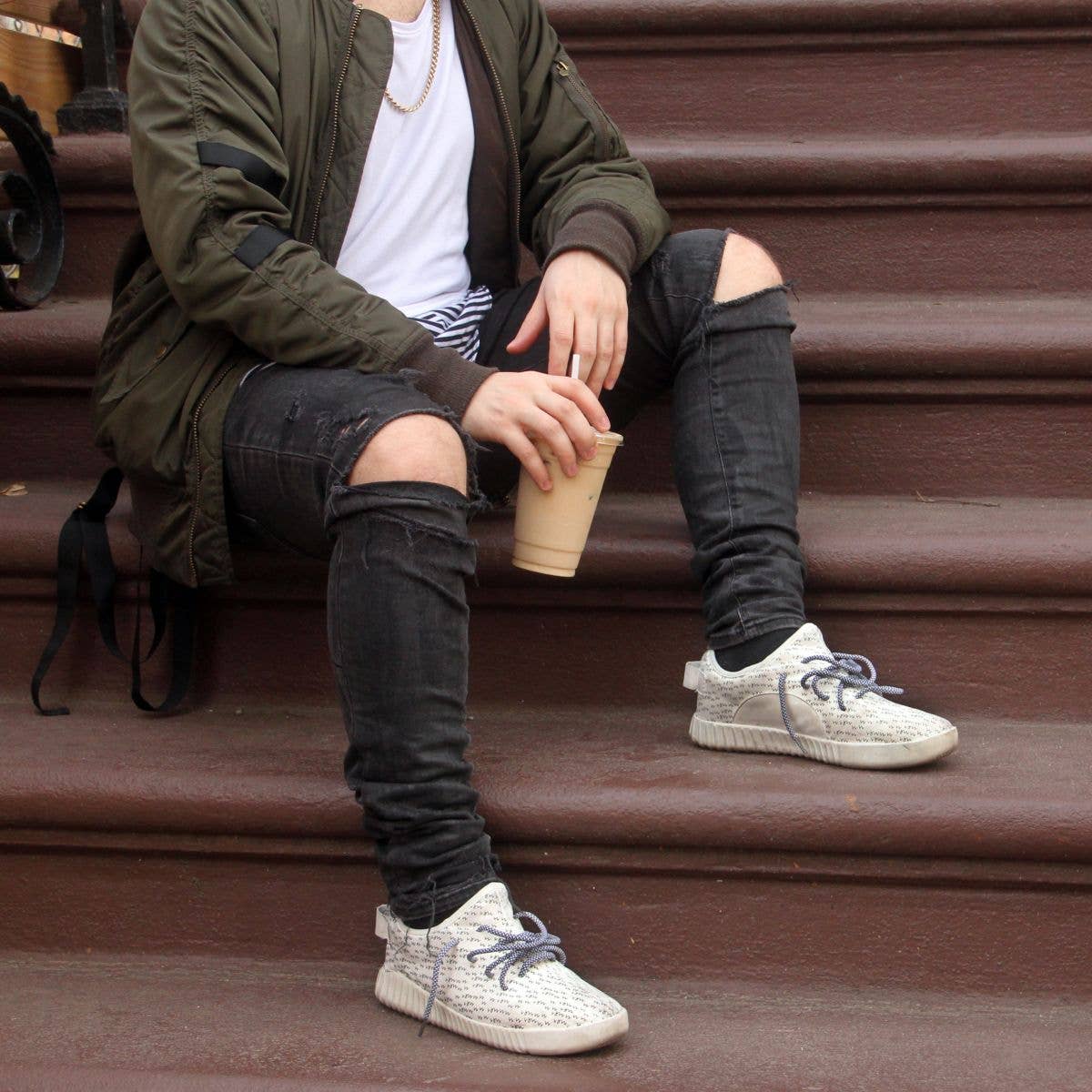1.
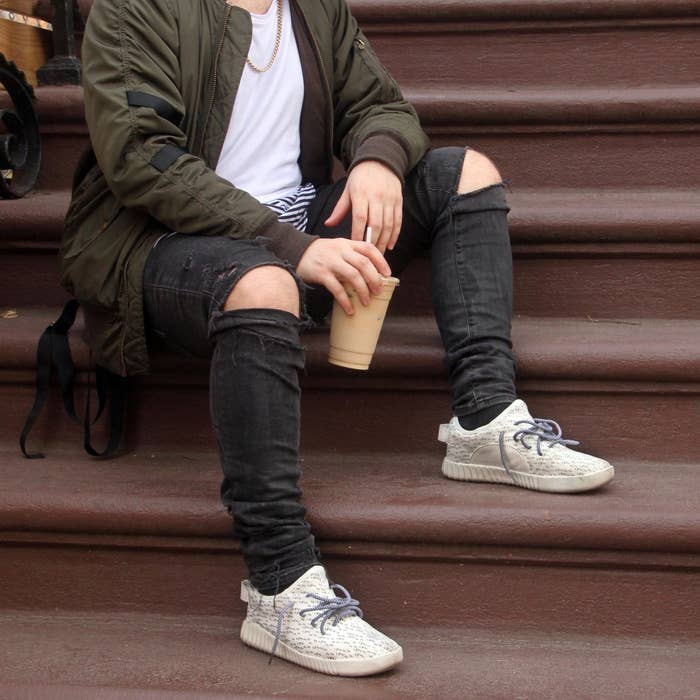
by Pete Forester
I wore fake Yeezys for 30 days and it fucked me up. It fucked me up more than I thought it would and for deeper reasons than I thought it would.
It changed where I went to lunch every day, what time I left work and what I did on the weekends. By the end of the 30 days, I spent more time in bed, was pulling away from my friends and was wearing clothes that had been dirtied more than a week before. It taught me lessons about myself that I knew I needed to learn and it forced me to consider socioeconomics and sartorial agency in ways I’d never thought of it before. It drew a line between fashion and spirituality that I had lived in but never noticed. And more than once it turned me into the smallest, most pathetic version of myself. That was terrifying.
My editor at Sole Collector and I were trying to think of what horrible things I could try in the name of sneaker journalism, and we settled on somehow limiting my sneaker choices for a month.
2.

Picking just one shoe wasn’t really going to bother me, and sticking to certain brands wouldn't be much of an annoyance either. But a few weeks shy of November, Complex posted an article on sneaker company Havik that features a product line that is almost exclusively fake Yeezy sneakers. When my editor proposed that this be the choice I immediately cringed. I had looked at the shoes with a sort of repulsive humor, the way that one watches pimple popping videos on YouTube.
I knew my revulsion was a good sign. It meant that I hated the idea and that I would probably learn something from it. And then I could turn that lesson into something that other people might gain something from.
I wanted to get a mix of shoes that would beg different responses. I wanted to make sure the shoes weren’t good fakes. Good fakes would go completely unnoticed, rendering the larger scope of the project useless. The shoes had to look like they were trying and failing to be Yeezys.
We ordered the sneakers and waited. These were the official rules:
- I would wear them for the month of November.
- Social media posting of sneakers I own were brought down an absolute minimum (unless they were these sneakers).
- I would get a few days off that I could choose at my discretion (I assumed I would use these for laundry days when I would walk down Fulton Street).
- I would only tell people what I was doing if they asked and only after I got their gut responses.
A week or so later and the sneakers arrived. Here’s what you have to know about them: they look terrible. Laughable. The 750s that look something like the real thing in the pictures aren’t anything close to seeming real. And most of them were horrendously uncomfortable. When I met with my friend to photograph them while wearing Kanye-inspired clothes in the marble caverns of downtown Manhattan, it was soundtracked by our uncontrollable laughter.
"I wore them to be gawked at, to be made fun of, to have the opinions of others be exacted against me. This was what I wanted. I wanted to learn from this moment."
3.
Being in on the joke is an easy armor, something I use for most things. I maintain that I’m pretty unembarassable, but I realize now that’s because I’m really only willing to do things that people will notice that I’m in on the joke about. I’m willing to air out all my secrets because my life is my own and even if I’m not proud of everything, I’m happy to take ownership of it. I’m happy to dance around Times Square in a tutu, but wearing fake Yeezys was hard for me. Really hard.
4.
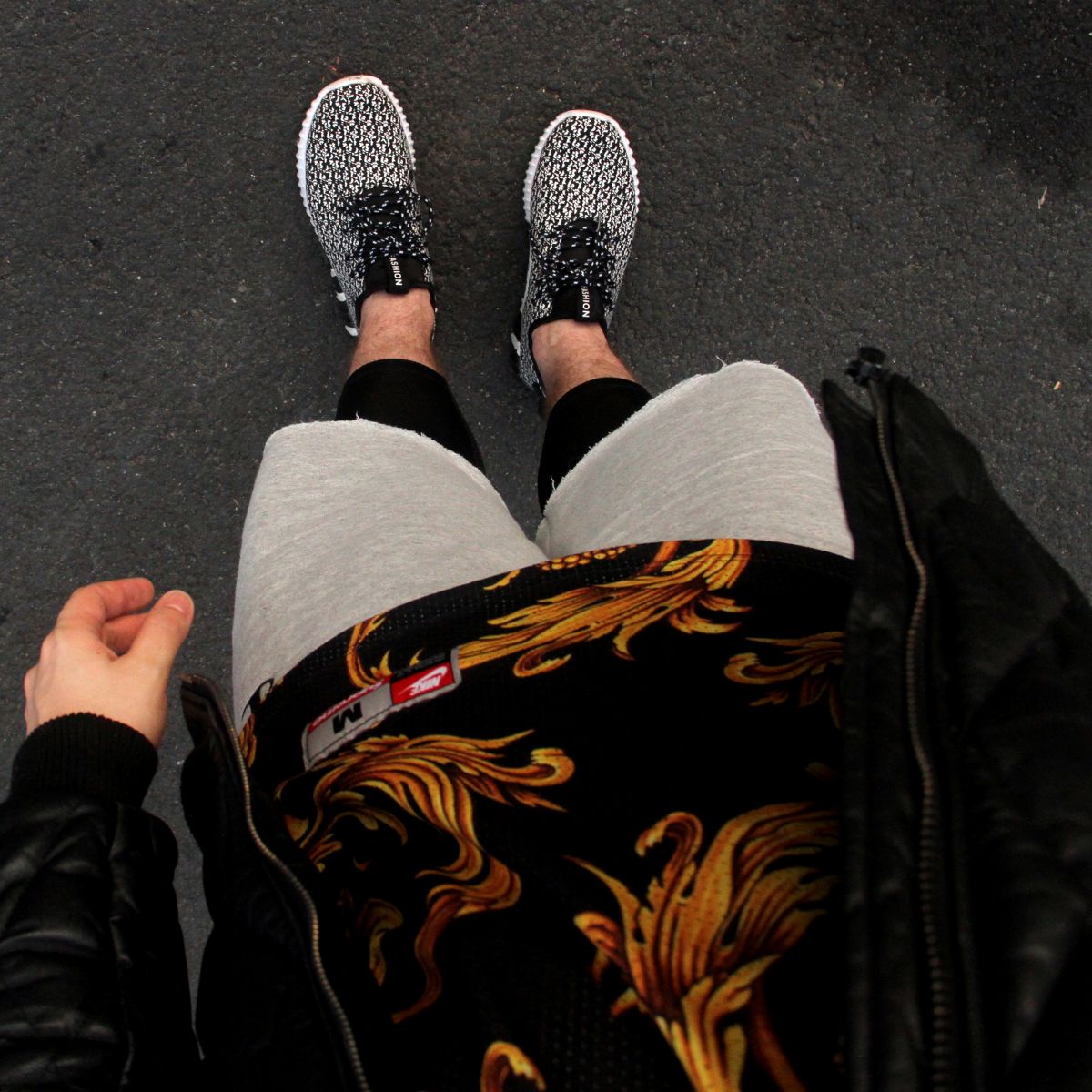
When Buddhist acolytes join a monastery they're given a bowl and a robe and sent out into the world to beg for two years. It's designed to destroy one of the strongest aspects of human nature, and one of the worst: ego. After those two years they understand that they are a tool to be used by those who need them. From that place, and only from that place, they are emancipated from expectation and gilding themselves with anything superfluous. Instead, they live from themselves with no expectation – seeing the world only for beauty. It is an expansive and outward facing existence.
That’s what I wanted. That’s what I was expecting from wearing these three pairs of fake shoes. I wanted to burn my ego.
Back at the Fulton Street PATH Station on November 1, I knew my friend with the camera wasn't laughing because he was embarrassed. He wasn't the one wearing fake shoes. When people walked by wearing Air Jordans, I found myself laughing louder. My laughter was a signal to people passing by that I was a person who had a friend, even if I was wearing fake Yeezys.
"If you feel like shit, but you look good, it’s much easier to face the day. When I was wearing Fake Yeezys for a month, it was really hard to feel good."
I was already pleading to strangers trying to prove that I had value as a human being. That was the first day. I had 29 more to go.
I’m prone to melancholy that’s been near fatal a few times in my life, but those of us who live with these things figure out how to deal with them (see: The Babadook). One of the ways I deal with my sadness is by dressing like a fucking king. This is important because if you feel like shit, but you look good, it’s much easier to face the day. When I was wearing fake Yeezys for a month, it was really hard to feel good.
It sounds petty and shallow. I know that tough anonymous guys whose joy is hopping on Twitter to cut down people who have taken risks by talking about their experience are going to latch onto this part of my story. “No man should care about shoes this much,” they’ll say, and then come Saturday you’ll find them @ing Nike’s Twitter account threatening them because they missed out on shoes. But when I can’t control how I present myself to the world, the only place to go is inward. That can be a dark and lonely place.
5.
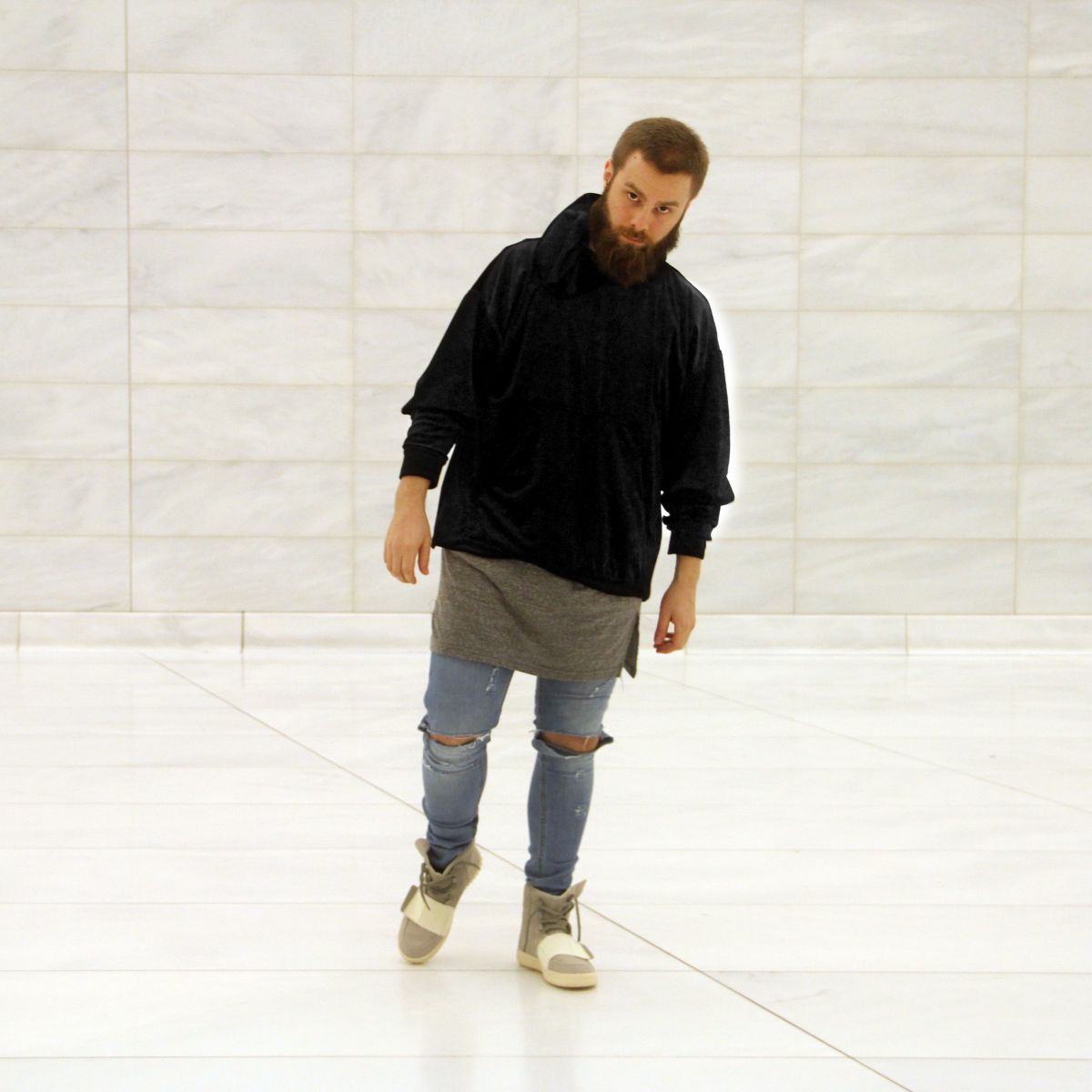
So when I put these horrible fake Yeezys on, that's what I stepped into. I’m pretty neurotic myself, but I felt like those begging monks in a very small way. I'm not begging and it's not in service to some spiritual journey, but I’m putting on a costume that feels worse than my daily wear whether or not someone else notices. Imagine the monk and his bowl being forced to go to his hometown, begging for change from his peers, relying on the pity of his childhood enemies. That’s what it felt like.
At one point this month I was on the subway looking down at my feet and cursing this project. I felt bad about myself; I felt like a loser. I felt like wherever I went people were staring at me and laughing at me for what I was wearing and what it meant about me.
These are not passable as fakes. I wanted them to be noticeably bad. I needed to know that people were going to stare (they did). I needed to know that people would surreptitiously take photos (they did). I needed to know that I would experience whole new levels of shame an embarrassment walking out into the world wearing these (I did). No one can wear these shoes and think that they’re actually fooling anyone.
So then why would anyone wear a pair of shoes that are so obviously fake, so obviously reaching toward an idea of something but totally missing it? Anyone who cares that you’d be wearing a pair of Yeezys is going to immediately notice that you’re not actually wearing a pair of Yeezys. Instead, ridicule quickly outpaces any tiny amount of passing currency, rendering the entire exercise worthless.
6.
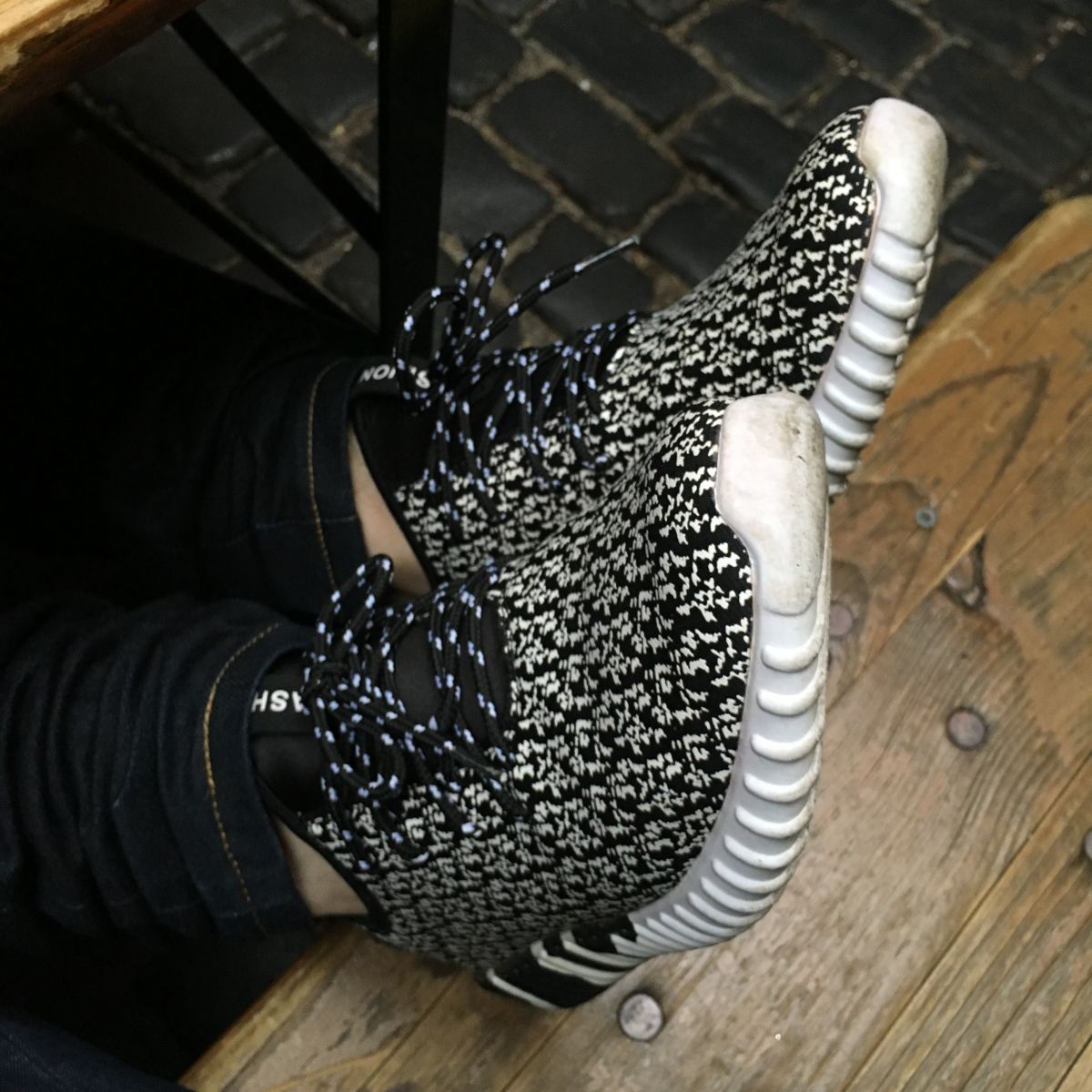
That sort of self-delusion breaks my heart. These shoes end up representing a rejection of reality, which is an unforgivable tragedy.
If everyone thinks "This will buy me value," then it ultimately means "This will make other people valuable." We are the reason fake sneakers exist. And we are the reason people buy them. We tell each other, and often tell ourselves, that these shoes are what give us, or others, value.
And when that is impossible for a buyer, they’re going to do whatever they can to get a piece of the lie that we’re selling.
Often, what inspires me to go out is to be flashy. I usually have a new pair of sneakers or a shirt I’m excited to wear. Maybe I remembered a pair of shoes I got a long time ago that I haven’t worn in a minute and my interest in them has resurfaced.
But with this assignment, I found myself staying in. I didn’t want people to see what I was wearing. I didn’t want to have to take ownership of them or answer for them. They felt like an extra appendage hanging off of me, like a being gripped into my shins wailing and sniveling. I wanted to apologize for myself.
That shrinking sense of self changed the way I dressed. I found myself confused over what clothes I should wear because of the way they would play against my shoes and shape the way people saw me. I could dress the way I normally dress, which is often with a real pair of Yeezys.
But, I started to panic wondering if this would hide the fact that I’m wearing fake shoes or if it would make them more obvious. Would people assume that the other pieces I was wearing, a Don C hat or a fur-lined jacket, were fake?
Or should I dress down completely, look like a total schlub, and then anyone who would notice my fake shoes would ignore me anyway and not even get to looking at my feet. I started to get exhausted with style and sneakers. And then realized, it was only exhausting because I felt like I was losing.
"The thought of 30 days was completely oppressive to me."
Of course it’s insane and totally self absorbed to assume that everyone was looking at me when I walked in a room wearing these shoes, but I started to avoid all eye contact anyway. I turned my headphones on, which is something I almost never do, in case anyone wanted to harass me.
I found myself staying in bed longer and longer. Not because I was particularly tired, but because I had nowhere I wanted to go. Obligations were there, of course, but nothing moved me out the door. Instead, I had three pairs of fake shoes that tied themselves to me and became a banner for my own falsity. The thought of 30 days was completely oppressive to me. Laying in that bed, about to put on my own version of Hester Prynne’s scarlet letter, I couldn’t move.
7.
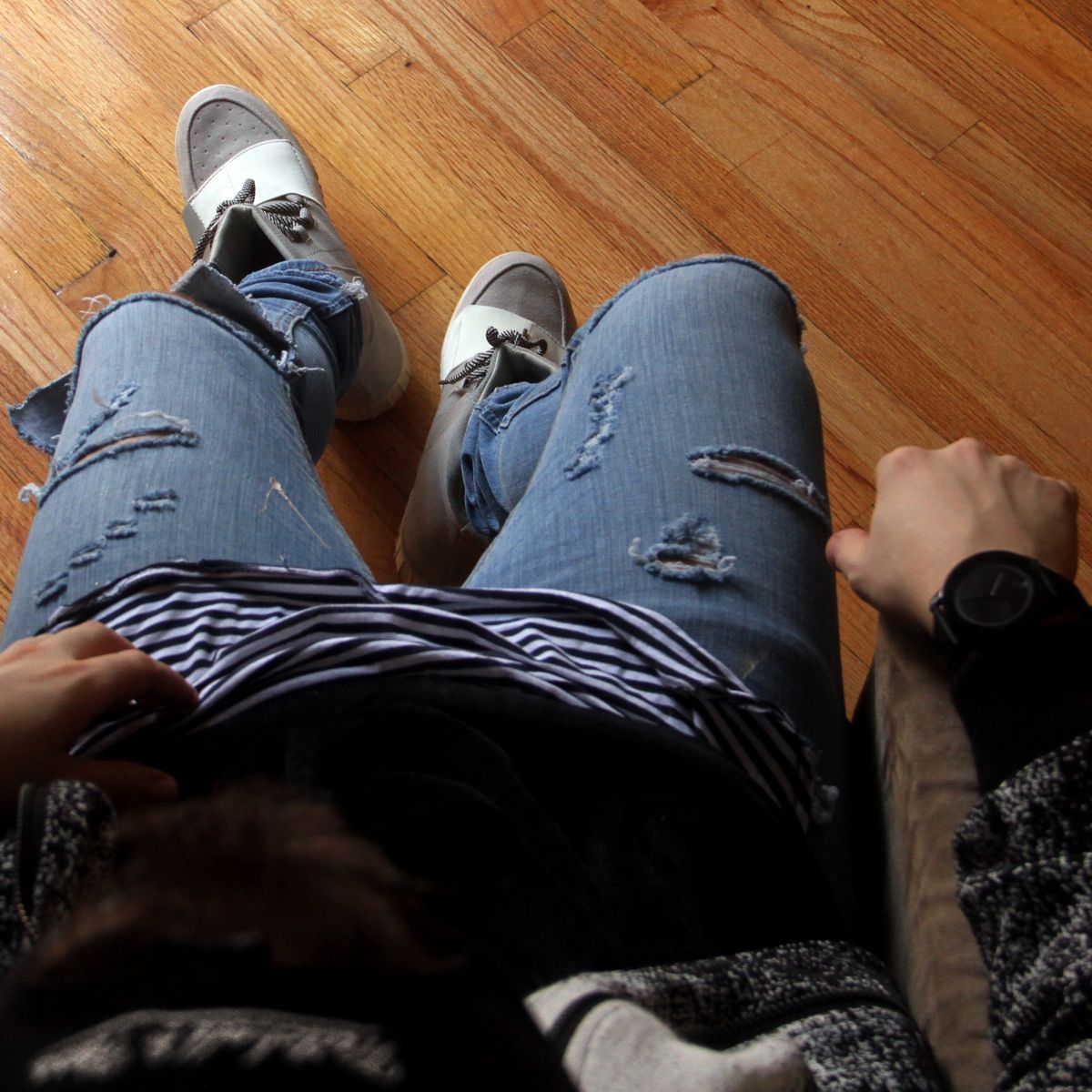
The project changed for me one day when I was laying in bed, about to be late to work again, dreading arriving in a public space wearing those fucking shoes again, subjecting myself to the looks and thoughts of strangers, feeling like a total phony. And then I realized I wasn’t alone in this. I have a brother dealing with alcoholism who gets up every day and faces the world with his own challenges that most of us will never truly understand, and many who won’t even notice.
They’re his secret battles that he hides in daily interaction because most people just want the answer to “How are you?” to be “Good, how are you?” They don’t want the real answer of what it’s like to live in this world that is too often a challenge. We’ve all agreed to pretend to be well all the time and we do it for one another. It’s a contract we’ve signed that makes everything a little easier and if you’re not willing to play, we’ve let be known, don’t enter the field at all. “I’m fine,” is fake, and it’s a hard lie. Impossible for some. But everyone has to figure out how to tell it, or risk being excised. Of course I’m fake. We’re all fake in some way.
Programs, like the one my brother goes through, say to take it one day at a time. When I let that play on me for a moment it changed everything. The idea of doing it for four more weeks was just insane to me. But what got me out the door was deciding that I would worry about just doing it that one day.
I’d worry about tomorrow tomorrow. It was incredibly liberating. I learned not to fight tomorrow’s battles until they came. It would mean that I was only a fraud today, but tomorrow was totally open and available for me. And if I did that enough times, it would eventually end. And it did.
"We’re all fake in some way."
Before anyone says, “No grown man should let shoes give them feelings like this,” let me say that my feelings aren’t what’s wrong. Every part of the fashion world, whether it’s clothes, shoes, or anything else, is about selling aspirationalism – selling an idea of something that you aren’t. Cultural forces outside of fashion tell us that this hocking of idealism is a bad thing, and it can be, but it can also operate the other way.
We assume that our clothes are speaking for us, and their clothes are speaking for them. But it only means what we make it mean. Certainly, the dude skipping on an $80 pair of Air Force Ones for a pair of really bad fake Yeezys has some trouble with judgment, but maybe there’s a grey line between what’s acceptable and what’s not. This is optional; we choose to call ourselves this. If we do it with a conscious mind, it doesn't have to mean anything.
We’ve all felt it. Getting that fresh pair that you were hoping for or hunting after for weeks or months. Opening the box, filling your lungs with the smell, holding them in your hands for the first time – fantasy becomes tangible reality in that moment. And then you put them on and you feel like a million bucks. You walk outside and even if no one is looking it feels like the world is gazing upon you, congratulating you for your good taste and wishing they could be just like you. That’s what we get in a box for $150.
8.
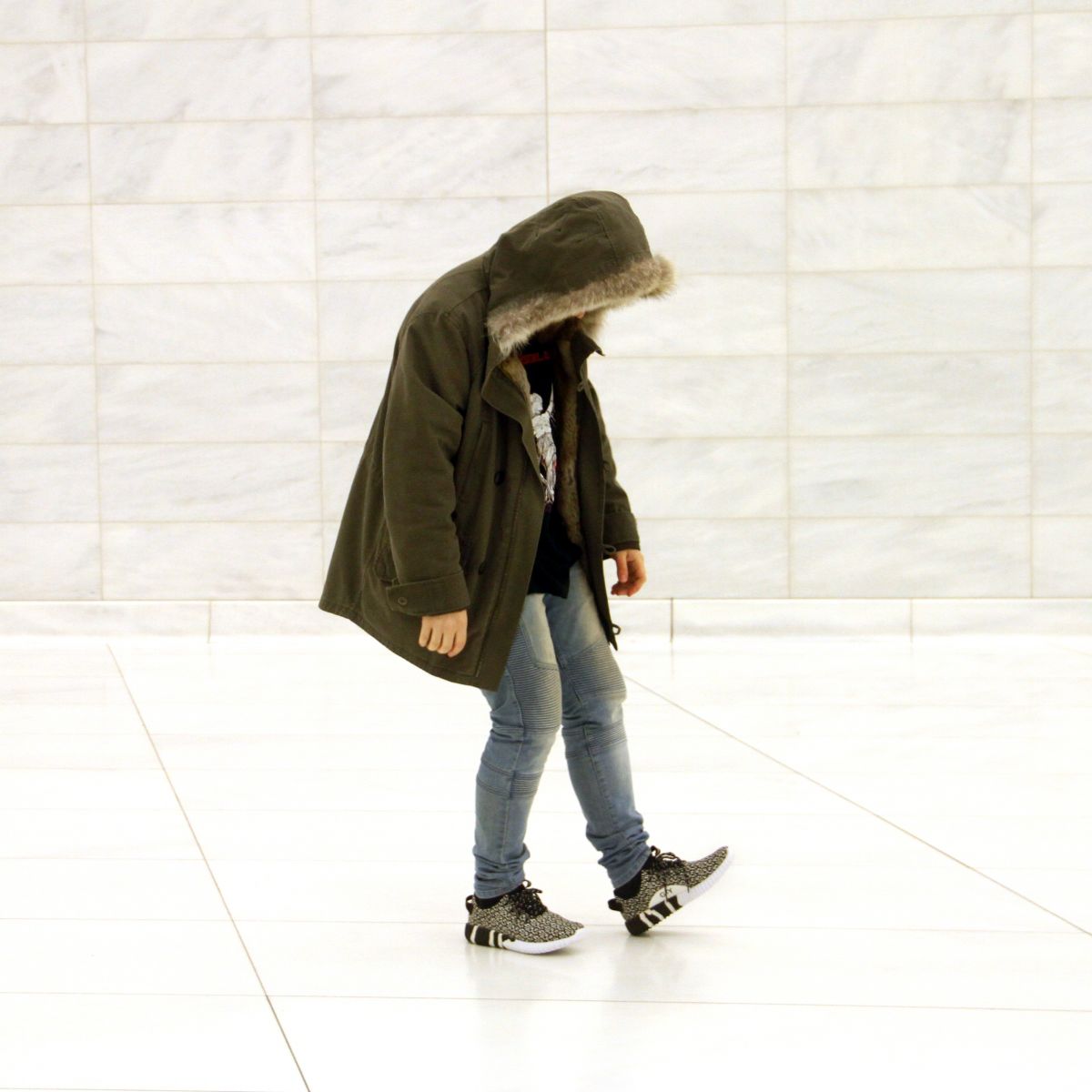
The problem is when we start to believe that there are two worlds and certain sneakers will offer us invitation into the other. That’s when people start to lose their minds. That’s when fights break out in sneaker lines, when fists are thrown, when guns are pulled. That’s when people go hungry or skip rent to get the latest pair of Jordans. That’s when people get beat up or murdered for the sneakers on their feet. That’s when we start to believe our own hype.
It’s fake. And it can be maintained as long as it’s fed with new releases and new perceived respect from strangers, whether it’s kind words on the street, or fake Internet points.
By the end of November, it got easier. I didn’t care any less, I just became so exhausted that I almost started having an out of body experience. I didn’t take the stares personally anymore because I was just too tired of it. Like I knew on the first day that that it wasn’t a reflection on my value as a human, I knew it on day 29 when the most overt photograph was taken of my shoes.
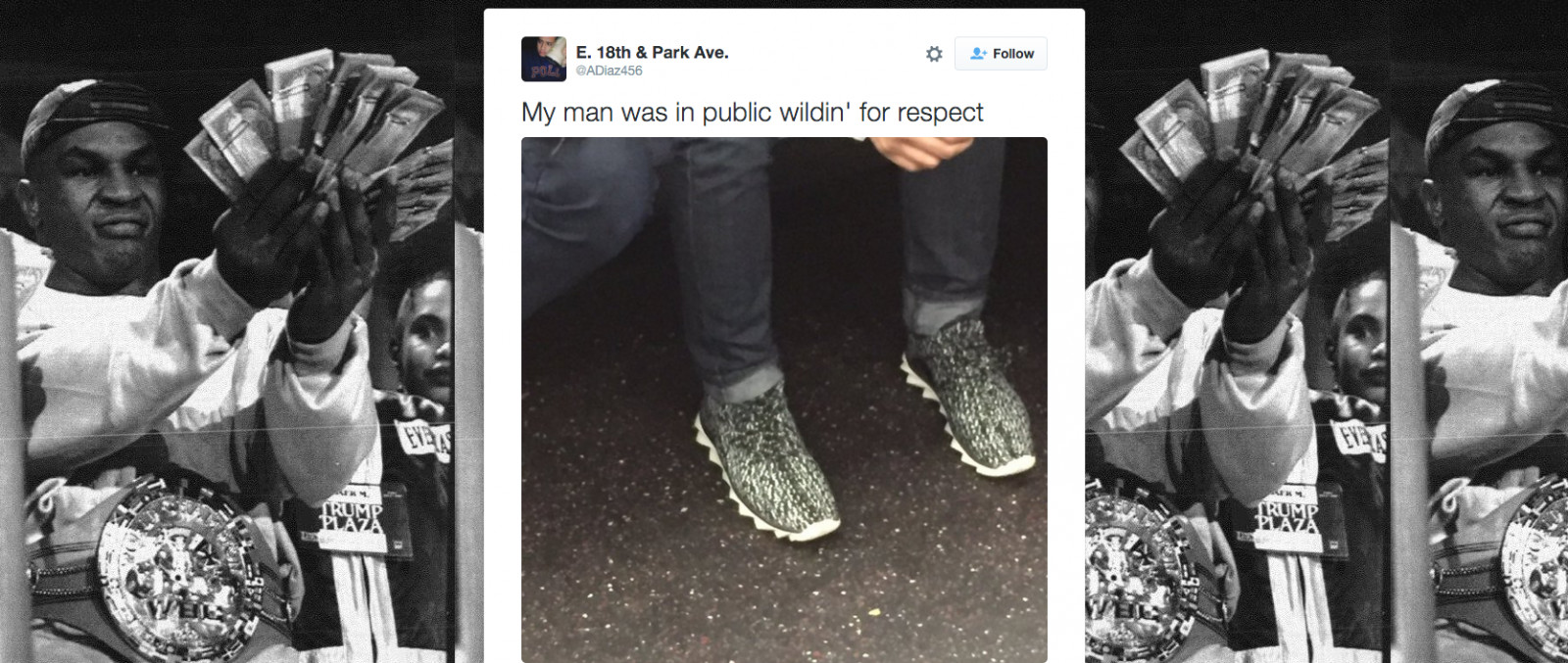
I looked on as someone did it on the C train and I pretended not to notice. He looked at the sneakers confused, but didn’t look at my face. After he took the photo, he cradled his phone in his hand, ostensibly either attempting to identify them or gawk at their own insulting existence. I felt something like pride having him take that photo, since that’s why I was wearing them.
I wore them to be gawked at, to be made fun of, to have the opinions of others be exacted against me. This was what I wanted. I wanted to learn from this moment.
When I got home I put them aside. And then I didn’t touch them. I didn’t throw them away or put them in the back of my closet. Today, they’re still out on my floor, not on my shelves. I learned something from them; I learned perhaps a lot of things from them. But I don’t keep them as reminders. I don’t keep them as talismans, or trinkets from that great trip into a different experience. I keep them because I’m going to burn them.

